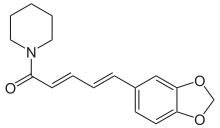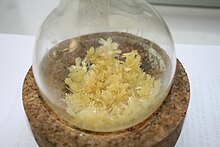Piperine

| |

| |
| Names | |
|---|---|
| Preferred IUPAC name
(2E,4E)-5-(2H-1,3-Benzodioxol-5-yl)-1-(piperidin-1-yl)penta-2,4-dien-1-one | |
| Other names
(2E,4E)-5-(Benzo[d][1,3]dioxol-5-yl)-1-(piperidin-1-yl)penta-2,4-dien-1-one
Piperoylpiperidine Bioperine | |
| Identifiers | |
3D model (JSmol)
|
|
| ChEBI | |
| ChEMBL | |
| ChemSpider | |
| ECHA InfoCard | 100.002.135 |
PubChem CID
|
|
| UNII | |
CompTox Dashboard (EPA)
|
|
| |
| |
| Properties | |
| C17H19NO3 | |
| Molar mass | 285.343 g·mol−1 |
| Density | 1.193 g/cm3 |
| Melting point | 130 °C (266 °F; 403 K) |
| Boiling point | Decomposes |
| 40 mg/l | |
| Solubility in ethanol | soluble |
| Solubility in chloroform | 1 g/1.7 ml |
| Hazards | |
| Safety data sheet (SDS) | MSDS for piperine |
Except where otherwise noted, data are given for materials in their standard state (at 25 °C [77 °F], 100 kPa).
| |
| Piperine | |
|---|---|
| Scoville scale | 150,000[1] SHU |
Piperine, possibly along with its isomer chavicine,[2] is the compound[3] responsible for the pungency of black pepper and long pepper. It has been used in some forms of traditional medicine.[4]
Preparation
[edit]Due to its poor solubility in water, piperine is typically extracted from black pepper by using organic solvents like dichloromethane.[5] The amount of piperine varies from 1–2% in long pepper, to 5–10% in commercial white and black peppers.[6][7]
Piperine can also be prepared by treating the solvent-free residue from a concentrated alcoholic extract of black pepper with a solution of potassium hydroxide to remove resin (said to contain chavicine, an isomer of piperine).[7] The solution is decanted from the insoluble residue and left to stand overnight in alcohol. During this period, the alkaloid slowly crystallizes from the solution.[8]
Piperine has been synthesized by the action of piperonoyl chloride on piperidine.[7]
Reactions
[edit]Piperine forms salts only with strong acids. The platinichloride B4·H2PtCl6 forms orange-red needles ("B" denotes one mole of the alkaloid base in this and the following formula). Iodine in potassium iodide added to an alcoholic solution of the base in the presence of a little hydrochloric acid gives a characteristic periodide, B2·HI·I2, crystallizing in steel-blue needles with melting point 145 °C.[7]
Piperine can be hydrolyzed by an alkali into piperidine and piperic acid.[7]
In light, especially ultraviolet light, piperine is changed into its isomers chavicine, isochavicine and isopiperine, which are tasteless.[9][2]
History
[edit]Piperine was discovered in 1819 by Hans Christian Ørsted, who isolated it from the fruits of Piper nigrum, the source plant of both black and white pepper.[10] Piperine was also found in Piper longum and Piper officinarum (Miq.) C. DC. (=Piper retrofractum Vahl), two species called "long pepper".[11]
See also
[edit]- Piperidine, a cyclic six-membered amine that results from hydrolysis of piperine
- Piperic acid, the carboxylic acid also derived from hydrolysis of piperine
- Capsaicin, the active piquant chemical in chili peppers
- Allyl isothiocyanate, the active piquant chemical in mustard, radishes, horseradish, and wasabi
- Allicin, the active piquant flavor chemical in raw garlic and onions (see those articles for discussion of other chemicals in them relating to pungency, and eye irritation)
- Ilepcimide
- Piperlongumine
References
[edit]- ^ Mangathayaru, K. (2013). Pharmacognosy: An Indian perspective. Pearson Education India. p. 274. ISBN 9789332520264.
- ^ a b De Cleyn, R; Verzele, M (1972). "Constituents of peppers. I Qualitative Analysis of Piperine Isomers" (PDF). Chromatografia. 5: 346–350. doi:10.1007/BF02315254. S2CID 56022338. Retrieved 26 September 2023.
- ^ The Merck Index: An Encyclopedia of Chemicals, Drugs, and Biologicals (11th ed.), Merck, 1989, p. 7442, ISBN 091191028X
- ^ Srinivasan, K. (2007). "Black pepper and its pungent principle-piperine: A review of diverse physiological effects". Critical Reviews in Food Science and Nutrition. 47 (8): 735–748. doi:10.1080/10408390601062054. PMID 17987447. S2CID 42908718.
- ^ Epstein, William W.; Netz, David F.; Seidel, Jimmy L. (1993). "Isolation of Piperine from Black Pepper". J. Chem. Educ. 70 (7): 598. Bibcode:1993JChEd..70..598E. doi:10.1021/ed070p598.
- ^ "Pepper". Tis-gdv.de. Retrieved 2 September 2017.
- ^ a b c d e Henry, Thomas Anderson (1949). "Piperine". The Plant Alkaloids (4th ed.). The Blakiston Company. p. 1-2.
- ^ Ikan, Raphael (1991). Natural Products: A Laboratory Guide (2nd ed.). San Diego, CA: Academic Press. pp. 223–224. ISBN 0123705517.
- ^ Kozukue, Nobuyuki; Park, Mal-Sun; others, and 5 (2007). "Kinetics of Light-Induced Cis−Trans Isomerization of Four Piperines and Their Levels in Ground Black Peppers as Determined by HPLC and LC/MS". J. Agric. Food Chem. 55 (17): 7131–7139. doi:10.1021/jf070831p. PMID 17661483. Retrieved 26 September 2023.
{{cite journal}}: CS1 maint: numeric names: authors list (link) - ^ Ørsted, Hans Christian (1820). "Über das Piperin, ein neues Pflanzenalkaloid" [On piperine, a new plant alkaloid]. Schweiggers Journal für Chemie und Physik (in German). 29 (1): 80–82.
- ^ Friedrich A. Fluckiger; Daniel Hanbury (1879). Pharmacographia : a History of the Principal Drugs of Vegetable Origin, Met with in Great Britain and British India. London: Macmillan. p. 584. ASIN B00432KEP2.
